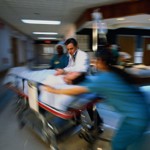 Medical emergencies can happen in anywhere including the dental office. It is important to know how to prevent and manage medical emergencies because they can be life threatening. Below are some common medical emergencies that can take place inside a dental clinic.
Medical emergencies can happen in anywhere including the dental office. It is important to know how to prevent and manage medical emergencies because they can be life threatening. Below are some common medical emergencies that can take place inside a dental clinic.
(1)Sudden loss of consciousness
(i) Vasovagal attack/fainting is the most common cause of sudden loss of consciousness in dental office. It is normally associated with anxiety, fear, fatigue, high temperature and etc. Surprisingly, young males are prone to faint after injection.
 Symptoms observed before vasovagal attack/fainting: Cool clammy skin, pallor, bradycardia (slow heart rate) and low pulse volume followed by tachycardia (fast heart rate) and loss of consciousness.
Vasovagal attack is normally recovered by placing the patient supine (flat on the floor) or by tilting his head slightly down to increase blood flow to the brain.
(ii) Hypoglycemia (low level of blood glucose)
Hypoglycemia can lead to loss of consciousness in the dental office. Hypoglycemia often occurs in patients who attend the dental appointment with an empty stomach or diabetic patients with relative insulin overdose. To manage a conscious hypoglycemic patient, your dental practitioner will most likely administer him/her with a 150ml glucose drink and a glucagon injection if patient is unconscious.
Symptoms of hypoglycemia: You will feel drowsy, disoriented, confusion, anxiety and etc.
(iv) Cardiac arrest /heart attack
Cardiac arrest is the most serious cause of sudden collapse and it can be fatal. Thus, it is important to discuss with the dental practitioner about your medical history (if you are having any) before getting any dental treatment done. It can be difficult to recognize if a patient is having cardiac arrest if he/she is sedated or anaesthetized. The diagnosis of cardiac arrest is confirmed if no pulse is detected and patient is unconscious.  It is important for any dental personnel to stay calm and perform basic life support in order to save the patient’s life.
 What will the dental practitioner do to manage a patient with cardiac arrest?
- Ask someone to call for help.
- Clear the area from danger.
- Assess whether the patient‘s response by shaking and shouting.
- Lay him flat on the floor.
- Tilt his head back and lift the patient’s chin.
- Check and remove any foreign materials present from the patient’s mouth.
- Assess patient’s breathing by listening and observing chest movements.(up to 10 seconds)
- Give two breaths (mouth to mouth) and watch for the person’s chest to rise.
- Assess the patient’s pulse. If pulse is present but there is no breathing, give another 10 breaths (ventilations) and recheck the pulse every minute.
- If there is no pulse, perform 15 chest compressions on the lower third of sternum at the rate of 100 per minute, followed by 2 ventilations.
- If pulse is restored /detected, reassess patient’s breathing and place him in a recovery position. Otherwise, you should continue giving him breaths and chest compression until help arrives.
Loss of consciousness can also follow several other emergencies such as respiratory obstruction (difficulty in breathing), epilepsy, and stroke.
(ii) Chest pain
Acute chest pain can be due to angina or myocardial infarction (loss of blood supply to a part of heart)
 Symptoms of chest pain: Severe crushing retrosternal pain, breathlessness, vomiting and loss of consciousness.
Management of acute chest pain:
Normally the dental practitioner will ask the patient to place their anti angina drugs sublingually. If there is no relief of pain in 3 minutes, the patient is most likely to have a myocardial infarction. Call for medical assistance and ask the patient to chew aspirin. Aspirin inhibits formation of blood clots that can clog the arteries. Nitrous oxide and oxygen will be given to the patient to relieve the pain and anxiety.